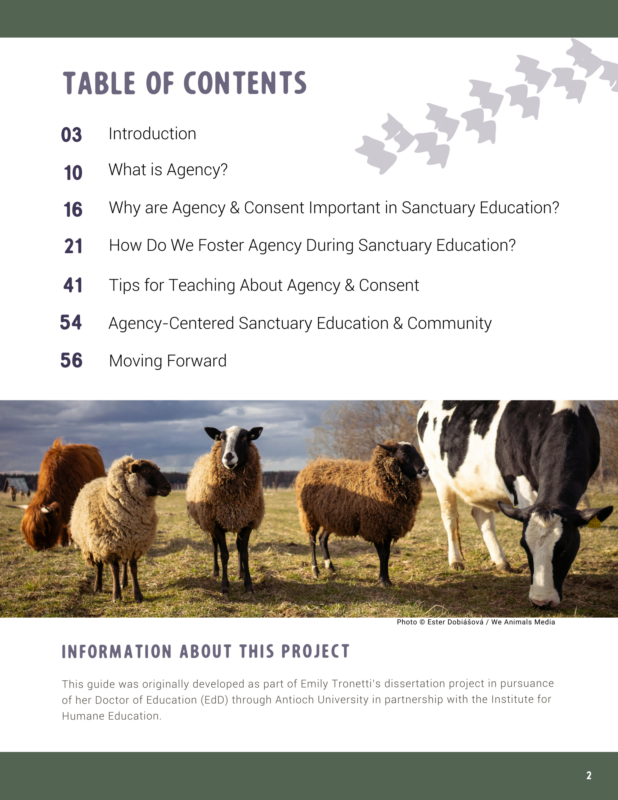Resource Acknowledgement
The following resource was originally developed for The Open Sanctuary Project as part of Dr. Emily Tronetti’s dissertation project in pursuance of her Doctor of Education (EdD) through Antioch University and the Institute for Humane Education. Emily specializes in adult humane education and applied animal behavior, and is passionate about helping advocates and organizations cultivate compassionate coexistence through teaching about and supporting the agency and wellbeing of other animals. We are so grateful for her collaborative efforts and contributions to The Open Sanctuary Project.
This Resource is Part of a Series!
This resource is the second in a series that explores agency and consent in farmed animalsA species or specific breed of animal that is raised by humans for the use of their bodies or what comes from their bodies. and how the application of agency-centered practices in sanctuary settings can enhance resident well being. To read the first resource of this series, “An Introduction to Fostering Agency in Farmed Animals at Your Animal Sanctuary”, click here!
Non-Compassionate Sources
We at The Open Sanctuary Project disavow animal experimentation and any “use” of animals for human purposes. Because compassionate studies on valuing the personality, intelligence, and unique attributes of many nonhuman animals are rare, in this resource, we draw from existing sources that may be non-compassionate. Still, we may use the information we find to improve the lives of residents. We strive towards a future when compassionate, non-exploitative, and non-invasive research is the norm. In the meantime, we will work with what we have to help sanctuaries help animals as effectively as possible. You can read a little bit more about our non-compassionate source policy here.
About the Guide
This resource is a comprehensive 68-page guide that explores the many ways that sanctuary educators can center and teach about resident agency and consent during their education and outreachAn activity or campaign to share information with the public or a specific group. Typically used in reference to an organization’s efforts to share their mission. efforts. While this guide is applicable to all forms of sanctuary education that involve farmed animals, it is especially relevant to sanctuaries with visitor programs that are interested in maximizing the impact of their programs while maintaining the residents’ well-being as their top priority. It is intended to help folks think critically about the various implications and impacts that these programs can have on residents and discover which educational approaches work best for their sanctuary, their staff, and, most importantly, the residents.
Contents of the Guide
- Introduction
- What is Agency?
- Why are Agency and Consent Important in Sanctuary Education?
- How Do We Foster Agency During Sanctuary Education?
- Tips for Teaching About Agency and Consent
- Agency-Centered Sanctuary Education and Community
- Moving Forward
Download the Guide
Enter either your organization’s name or your name and email below to download the guide!
We promise not to use your email for any marketing purposes!
Interested in Accessing the Guide in a Different Format?
This resource is a fully-downloadable guide that was originally developed as a comprehensive resource. While we highly recommend checking out and downloading the full-length version of the guide on this page, we also recognize the benefits of breaking down larger resources like this into multiple smaller resources for folks who are interested in accessing it in a different format. As such, we have also published the guide as six individual parts/standalone resources. To access the standalone resources, please click the following links: Part One, Part Two, Part Three, Part Four, Part Five, Part Six.
We’d Love to Hear from You!
This guide is a living document that we plan to make continual changes to as we get feedback from sanctuary staff and volunteers who have implemented what they’ve learned from this guide into their sanctuary education practices. In our efforts to ensure this guide is as helpful as possible to sanctuary staff, volunteers, visitors, supporters, and, most importantly, the residents, we’d love to hear how this guide has impacted your work. If you have feedback, please contact us here!















